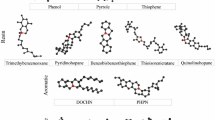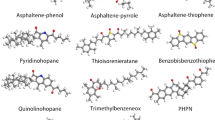Abstract
The compatibility between asphalt and nanosilica (nano-SiO2) is critical to determine the performance of nano-SiO2–modified asphalt. However, a comprehensive understanding of the compatibility behavior and mechanism of asphalt components and nano-SiO2 in the modified asphalt is still limited. In this study, the compatibility was revealed through molecular dynamics (MD) simulation. Virgin asphalt, nano-SiO2–modified asphalt, and oxidation aged asphalt models produced with the COMPASS force field; meanwhile, the proposed models were validated by comparisons with reference data. The compatibility of asphalt and nano-SiO2 was analyzed by solubility and the Flory–Huggins parameters and interaction energy. Results show that the solubility parameters decreased with the increase of system temperature while increased with the asphalt’s oxidation level increase. Meanwhile, the compatibility of the asphaltene, resin, and aromatic components in asphalt is better than the compatibility with saturates, which may be due to saturates being volatile; however, the compatibility of the nano-SiO2 and saturates is much better than those with asphaltene, resin, and aromatic components. The incorporation of nano-SiO2 alleviates the volatilization of saturates. The present results provide insights into the understanding of the compatibility behavior and mechanism of nano-SiO2 and asphalt components.















Similar content being viewed by others
Data availability
All data generated or analyzed during this study are included in this published article.
Code availability
The calculations have been carried out using LAMMPS and Materials Studio 2017 R2.
References
Xu T, Huang X (2012) Investigation into causes of in-place rutting in asphalt pavement. Constr Build Mater 28(1):525–530
Nejad FM, Aflaki E, Mohammadi MA (2010) Fatigue behavior of SMA and HMA mixtures. Constr Build Mater 24(7):1158–1165
Liu C, Lv S, Peng X, Zheng J, Yu M (2020) Analysis and comparison of different impacts of aging and loading frequency on fatigue characterization of asphalt concrete. J Mater Civ Eng 32(9):04020240
You L, You Z, Dai Q, Guo S, Wang J, Schultz M (2018) Characteristics of water-foamed asphalt mixture under multiple freeze-thaw cycles: laboratory evaluation. J Mater Civ Eng 30(11):04018270
Islam M, Mannan U, Rahman ASM, Tarefder R (2014) Effects of reclaimed asphalt pavement on hot-mix asphalt. J Adv Civ Eng Mater 3:291–307
Ho C, Martin Linares CP, Shan J, Almonnieay A (2017) Material testing apparatus and procedures for evaluating freeze-thaw resistance of asphalt concrete mixtures. Adv Civ Eng Mater 6(1):429–443
Wang W, Wang L, Miao Y et al (2020) A survey on the influence of intense rainfall induced by climate warming on operation safety and service life of urban asphalt pavement. J Infrastruct Preserv Resil 1:4. https://doi.org/10.1186/s43065-020-00003-0
Jayanthi PNV, Singh DN (2016) Utilization of sustainable materials for soil stabilization: state-of-the-art. Adv Civ Eng Mater 5(1):20150013
Ashish PK, Singh D (2020) Investigating low-temperature properties of nano clay–modified asphalt through an energy-based approach. Adv Civ Eng Mater 9(1):67–89
Li R, Xiao F, Amirkhanian S, You Z, Huang J (2017) Developments of nano materials and technologies on asphalt materials—a review. Constr Build Mater 143:633–648
Karnati SR, Oldham D, Fini EH, Zhang L (2019) Surface functionalization of silica nanoparticles to enhance aging resistance of asphalt binder. Constr Build Mater 211:1065–1072
Crucho JML, Neves JMCD, Capitão SD, Picado-Santos LGD (2018) Mechanical performance of asphalt concrete modified with nanoparticles: nanosilica, zero-valent iron and nanoclay. Constr Build Mater 181:309–318
Lin M, Li P, Nian T, Mao Y, Kang X (2019) Performance evaluation and modification mechanism analysis of the synthesized rubber asphalt. Adv Civ Eng Mater 8(1):497–510. https://doi.org/10.1520/ACEM20190037
Li S, Huang K, Yang X, Li M, Xia J (2014) Design, preparation and characterization of novel toughened epoxy asphalt based on a vegetable oil derivative for bridge deck paving. RSC Adv 4(84):44741–44749
Zhou X, Wu S, Liu Q, Chen Z, Yi M (2015) Effect of surface active agents on the rheological properties and solubility of layered double hydroxides-modified asphalt. Materials research innovations: global conference on materials science and engineering (CMSE 2014) 19(sup5):S5–978–S5–982
Jiang Y, Liu Y, Gong J et al (2018) Microstructures, thermal and mechanical properties of epoxy asphalt binder modified by SBS containing various styrene-butadiene structures. Mater Struct 51:86. https://doi.org/10.1617/s11527-018-1217-9
Chen Z, Pei J, Li R, Xiao F (2018) Performance characteristics of asphalt materials based on molecular dynamics simulation—a review. Constr Build Mater 189:695–710
Xu G, Wang H (2017) Molecular dynamics study of oxidative aging effect on asphalt binder properties. Fuel 188:1–10
Qu X, Liu Q, Guo M, Wang D, Oeser M (2018) Study on the effect of aging on physical properties of asphalt binder from a microscale perspective. Constr Build Mater 187:718–729
Sun D, Sun G, Zhu X, Ye F, Xu J (2018) Intrinsic temperature sensitive self-healing character of asphalt binders based on molecular dynamics simulations. Fuel 211:609–620
He L, Li G, Lv S, Gao J, Kowalski KJ, Valentin J et al (2020) Self-healing behavior of asphalt system based on molecular dynamics simulation. Constr Build Mater 254:119225
Yu T, Zhang H, Wang Y (2020) Multi-gradient analysis of temperature self-healing of asphalt nano-cracks based on molecular simulation. Constr Build Mater 250:118859
Sun D, Lin T, Zhu X, Tian Y, Liu F (2016) Indices for self-healing performance assessments based on molecular dynamics simulation of asphalt binders. Comput Mater Sci 114:86–93
Wang P, Zhai F, Dong Z, Wang L, Liao J, Li G (2018) Micromorphology of asphalt modified by polymer and carbon nanotubes through molecular dynamics simulation and experiments: role of strengthened interfacial interactions. Energy Fuel 32(2):1179–1187
Yao H, Dai Q, You Z, Bick A, Wang M, Guo S (2017) Property analysis of exfoliated graphite nanoplatelets modified asphalt model using molecular dynamics (MD) method. Appl Sci 7(1):43
Long Z, You L, Tang X, Ma W, Ding Y, Xu F (2020) Analysis of interfacial adhesion properties of nanosilica modified asphalt mixtures using molecular dynamics simulation. Constr Build Mater 255:119354
Liu J, Yu B, Hong Q (2020) Molecular dynamics simulation of distribution and adhesion of asphalt components on steel slag. Constr Build Mater 255:119332
Sun W, Wang H (2020) Moisture effect on nanostructure and adhesion energy of asphalt on aggregate surface: a molecular dynamics study. Appl Surf Sci 510:145435
Luo L, Chu L, Fwa TF (2020) Molecular dynamics analysis of moisture effect on asphalt-aggregate adhesion considering anisotropic mineral surfaces. Appl Surf Sci 527:146830
Xu G, Wang H (2016) Study of cohesion and adhesion properties of asphalt concrete with molecular dynamics simulation. Comput Mater Sci 112:161–169
Sonibare K, Rathnayaka L, Zhang L (2020) Comparison of CHARMM and OPLS-aa forcefield predictions for components in one model asphalt mixture. Constr Build Mater 236:117577
Fallah F, Khabaz F, Kim Y, Kommidi SR, Haghshenas HF (2019) Molecular dynamics modeling and simulation of bituminous binder chemical aging due to variation of oxidation level and saturate-aromatic-resin-asphaltene fraction. Fuel 237:71–80
Khabaz F, Khare R (2015) Glass transition and molecular mobility in styrene–butadiene rubber modified asphalt. J Phys Chem B 119(44):14261–14269
Kang Y, Zhou D, Wu Q, Liang R, Shangguan S, Liao Z et al (2019) Molecular dynamics study on the glass forming process of asphalt. Constr Build Mater 214:430–440
Yao H, Dai Q, You Z, Bick A, Wang M (2018) Modulus simulation of asphalt binder models using molecular dynamics (MD) method. Constr Build Mater 162:430–441
Su M, Si C, Zhang Z, Zhang H (2020) Molecular dynamics study on influence of nano-ZnO/SBS on physical properties and molecular structure of asphalt binder. Fuel 263:116777
Yu X, Wang J, Si J, Mei J, Ding G, Li J (2020) Research on compatibility mechanism of biobased cold-mixed epoxy asphalt binder. Constr Build Mater 250:118868
Sun W, Wang H (2019) Molecular dynamics simulation of diffusion coefficients between different types of rejuvenator and aged asphalt binder. Int J Pavement Eng 21(8):1–11
Xu M, Yi J, Qi P, Wang H, Marasteanu M, Feng D (2019) Improved chemical system for molecular simulations of asphalt. Energy Fuel 33(4):3187–3198
Li DD, Greenfield ML (2014) Chemical compositions of improved model asphalt systems for molecular simulations. Fuel 115:347–356
DR Jones, SHRP materials reference library: asphalt cements: a concise data compilation 1993. Washington, DC
Zhang L, Greenfield ML (2007) Analyzing properties of model asphalts using molecular simulation. Energy Fuel 21(3):1712–1716
Wang H, Lin E, Xu G (2017) Molecular dynamics simulation of asphalt-aggregate interface adhesion strength with moisture effect. Int J Pavement Eng 18(5):414–423
Zhou X, Zhang X, Xu S, Wu S, Liu Q, Fan Z (2017) Evaluation of thermo-mechanical properties of graphene/carbon-nanotubes modified asphalt with molecular simulation. Mol Simul 43(4):312–319
Wang P, Dong Z, Tan Y, Liu Z (2015) Investigating the interactions of the saturate, aromatic, resin, and asphaltene four fractions in asphalt binders by molecular simulations. Energy Fuel 29(1):112–121
Yusoff NIM, Breem AAS, Alattug HNM, Hamim A, Ahmad J (2014) The effects of moisture susceptibility and ageing conditions on nanosilica/polymer-modified asphalt mixtures. Constr Build Mater 72:139–147
Dan H, Zou Z, Zhang Z, Tan J (2020) Effects of aggregate type and SBS copolymer on the interfacial heat transport ability of asphalt mixture using molecular dynamics simulation. Constr Build Mater 250:118922
Pan P, Wu S, Xiao Y, Wang P, Liu X (2014) Influence of graphite on the thermal characteristics and anti-ageing properties of asphalt binder. Constr Build Mater 68:220–226
PC Painter, The characterization of asphalt and asphalt recyclability 1993. Washington, DC: SHRP-A-675
Acknowledgements
The authors acknowledge the financial support of Hunan Provincial Natural Science Foundation of China (2019JJ50622), the Outstanding Young Projects of the Hunan Provincial Education Department (18B066), the Innovative Venture Technology Investment Project of Hunan Province (2018GK5028), the High-level Talent Gathering Project in Hunan Province (2019RS1059), and the Fundamental Research Funds for the Central Universities (2020kfyXJJS127). The authors are sincerely grateful for their financial support. The views and findings of this study represent those of the authors and may not reflect those of the funding agencies.
Author information
Authors and Affiliations
Contributions
Zhengwu Long: Conceptualization, Investigation, Methodology, Formal analysis, Writing - original draft; Sijia Zhou: Software, Formal analysis, Methodology, Writing - review & editing; Shaoting Jiang: Software, Methodology, Writing - review & editing; Wenbo Ma: Conceptualization, Funding acquisition, Writing - review & editing; Yanhuai Ding: Resources, Validation, Writing - review & editing; Lingyun You: Supervision, Conceptualization, Investigation, Methodology, Validation, Funding acquisition, Formal analysis, Writing - review & editing; Xianqiong Tang: Supervision, Conceptualization, Formal analysis, Writing - review & editing; Fu Xu: Supervision, Resources, Conceptualization, Writing - review & editing.
Corresponding authors
Ethics declarations
Ethics approval and consent to participate
The manuscript is prepared in compliance with the Ethics in Publishing Policy as described in the Guide for Authors. The manuscript is approved by all authors for publication.
Consent for publication
The consent for publication was obtained from all participants.
Conflict of interest
The authors declare that they have no conflict of interest.
Additional information
Publisher’s note
Springer Nature remains neutral with regard to jurisdictional claims in published maps and institutional affiliations.
Rights and permissions
About this article
Cite this article
Long, Z., Zhou, S., Jiang, S. et al. Revealing compatibility mechanism of nanosilica in asphalt through molecular dynamics simulation. J Mol Model 27, 81 (2021). https://doi.org/10.1007/s00894-021-04697-1
Received:
Accepted:
Published:
DOI: https://doi.org/10.1007/s00894-021-04697-1




